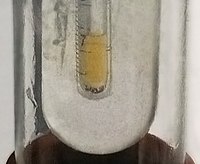
Precision medicine in renal stone-formers
Sign Up to like & getrecommendations! Published in 2018 at "Urolithiasis"
DOI: 10.1007/s00240-018-1091-5
Abstract: Here we define precision medicine approaches and discuss how these may be applied to renal stone-formers to optimise diagnosis and a management. Using the gene discovery of monogenic stone disorders as examples, we discuss the… read more here.
Keywords: medicine; precision medicine; stone; renal stone ... See more keywords

Assessment of conservative dietary management as a method for normalization of 24-h urine pH in stone formers
Sign Up to like & getrecommendations! Published in 2019 at "Urolithiasis"
DOI: 10.1007/s00240-019-01139-9
Abstract: Low urine pH is a metabolic risk factor for stone formation. While medical therapy is typically prescribed (as urinary alkalinization), patients typically prefer dietary modifications. We aimed to assess capacity to alter urine pH with… read more here.
Keywords: stone; increase; giaa; stone formers ... See more keywords

24-h urine metabolic profile: is it necessary in all kidney stone formers?
Sign Up to like & getrecommendations! Published in 2018 at "International Urology and Nephrology"
DOI: 10.1007/s11255-018-1902-1
Abstract: PurposeA 24-h urine metabolic profile (24-UMP) is an integral part of nephrolithiasis work-up. We aimed to explore whether it can be waived under certain circumstances.Materials and methodsWe reviewed our prospective registry database of patients seen… read more here.
Keywords: urine metabolic; stone; stone formers; metabolic profile ... See more keywords

24-Hour urine collection for first time pediatric stone formers: Is it worth it?
Sign Up to like & getrecommendations! Published in 2020 at "Journal of pediatric urology"
DOI: 10.1016/j.jpurol.2020.12.001
Abstract: INTRODUCTION/OBJECTIVE 24-h urine collections are recommended for motivated first-time stone formers. Given that children have a lifetime potential for recurrences, metabolic work-up has been recommended. 24-hour urine collections can be problematic, especially in children. We… read more here.
Keywords: stone formers; first time; stone; urine collection ... See more keywords

Increased production and reduced urinary buffering of acid in uric acid stone formers is ameliorated by pioglitazone.
Sign Up to like & getrecommendations! Published in 2019 at "Kidney international"
DOI: 10.1016/j.kint.2018.11.024
Abstract: Idiopathic uric acid nephrolithiasis is characterized by an overly acidic urine pH caused by the combination of increased acid production and inadequate buffering of urinary protons by ammonia. A large proportion of uric acid stone… read more here.
Keywords: uric acid; pioglitazone; stone formers; acid ... See more keywords

Age, Body Mass Index, and Gender Predict 24-Hour Urine Parameters in Recurrent Idiopathic Calcium Oxalate Stone Formers
Sign Up to like & getrecommendations! Published in 2017 at "Journal of Endourology"
DOI: 10.1089/end.2017.0352
Abstract: Abstract Introduction and Objective: Despite guidelines, routine 24-hour urine testing is completed in read more here.
Keywords: stone formers; hour urine; age body; body mass ... See more keywords

Dichotomous response to oral citrate in hypocitraturic stone formers
Sign Up to like & getrecommendations! Published in 2023 at "Physiology"
DOI: 10.1152/physiol.2023.38.s1.5732896
Abstract: Background and Hypothesis: Hypocitraturia is a marker of metabolic acidosis and a risk factor for kidney stone formation. Oral citrate replacement is a mainstay therapy for hypocitraturic nephrolithiasis. We have observed that a subpopulation of… read more here.
Keywords: citrate; stone formers; oral citrate; physiology ... See more keywords

Nuclear Magnetic Resonance Metabolomic Profiling and Urine Chemistries in Incident Kidney Stone Formers Compared with Controls.
Sign Up to like & getrecommendations! Published in 2022 at "Journal of the American Society of Nephrology : JASN"
DOI: 10.1681/asn.2022040416
Abstract: BACKGROUND The urine metabolites and chemistries that contribute to kidney stone formation are not fully understood. This study examined differences between the urine metabolic and chemistries profiles of first-time stone formers and controls. METHODS High-resolution… read more here.
Keywords: nuclear magnetic; urine chemistries; stone formers; stone ... See more keywords

Differences of Uric Acid Transporters Carrying Extracellular Vesicles in the Urine from Uric Acid and Calcium Stone Formers and Non-Stone Formers
Sign Up to like & getrecommendations! Published in 2022 at "International Journal of Molecular Sciences"
DOI: 10.3390/ijms231710010
Abstract: Background: Low urine pH and volume are established risk factors for uric acid (UA) stone disease (UASD). Renal tubular epithelial cells exposed to an acidic pH and/or UA crystals can shed extracellular vesicles (EVs) into… read more here.
Keywords: extracellular vesicles; non stone; stone formers; stone ... See more keywords